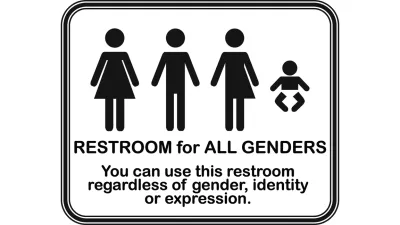There are several reasons that gender neutral bathrooms will soon replace separated men's and women's bathrooms, and they have nothing to do with gender identity, explains Jimmy Parker, event producer and former BID director.

Gender neutral bathrooms are just better. It has nothing to do with gender identity or current affairs. There are several reasons that gender neutral bathrooms will soon replace separate men's and women's bathrooms, explains event producer and the long time president of San Diego's Gaslamp Quarter Association—a Businsess Improvement District. A few of the reasons include:
Benefits
Once you begin to design standardized approaches to public restroom facilities, certain benefits will be realized. Here are a few:
- No need to calculate use based on demographics.
- No duplication of hand wash stations, signage, lighting, and general access corridors
- Easier family use (Fathers with daughters, Mother with sons)
- Easier calculation/conformance with ADA standards
Safety
This area seems to be where the greatest passion exists on both sides of the political debate, but I would ask the reader to consider the following:
- Unisex restrooms (shared areas) are easier to patrol with security personnel. With separate facilities, sex-specific guards need to be available to respond to emergencies/concerns.
- Greater traffic increases safety. The potential of swifter response to inappropriate behavior is a great deterrent.
- Children can be accompanied by both parents/grandparents. Especially important with multiple children.
- Stalls, unlike urinal dividers, can be re-enforced to provide better (not complete) protection when people need to shelter in place during violent incidents.
Parker concludes by asking planners and municipalities to remove remove regulatory obstacles to their implementation and to develop standards to allow all large scales public projects to have gender neutral bathroom facilities.
FULL STORY: A Planner’s Opportunity – Gender Neutral Facilities

Maui's Vacation Rental Debate Turns Ugly
Verbal attacks, misinformation campaigns and fistfights plague a high-stakes debate to convert thousands of vacation rentals into long-term housing.

Planetizen Federal Action Tracker
A weekly monitor of how Trump’s orders and actions are impacting planners and planning in America.

San Francisco Suspends Traffic Calming Amidst Record Deaths
Citing “a challenging fiscal landscape,” the city will cease the program on the heels of 42 traffic deaths, including 24 pedestrians.

Defunct Pittsburgh Power Plant to Become Residential Tower
A decommissioned steam heat plant will be redeveloped into almost 100 affordable housing units.

Trump Prompts Restructuring of Transportation Research Board in “Unprecedented Overreach”
The TRB has eliminated more than half of its committees including those focused on climate, equity, and cities.

Amtrak Rolls Out New Orleans to Alabama “Mardi Gras” Train
The new service will operate morning and evening departures between Mobile and New Orleans.
Urban Design for Planners 1: Software Tools
This six-course series explores essential urban design concepts using open source software and equips planners with the tools they need to participate fully in the urban design process.
Planning for Universal Design
Learn the tools for implementing Universal Design in planning regulations.
Heyer Gruel & Associates PA
JM Goldson LLC
Custer County Colorado
City of Camden Redevelopment Agency
City of Astoria
Transportation Research & Education Center (TREC) at Portland State University
Jefferson Parish Government
Camden Redevelopment Agency
City of Claremont




























